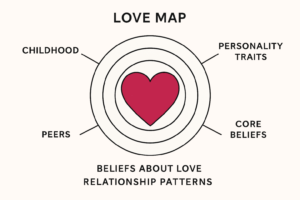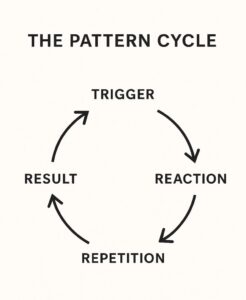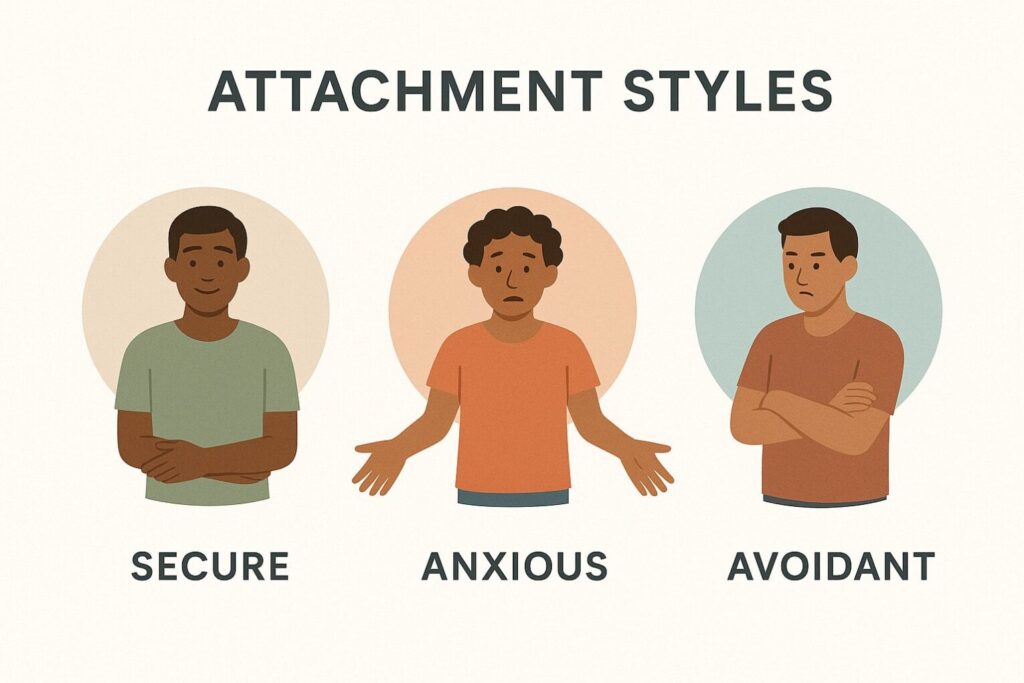I sensed the start of another one of those “push-pull” relationship cycles. I left my phone on my desk and told myself I’d wait for my lover to reach out. The longer the silence, the more my chest tightened, probably reflecting my attachment style, rooted in my babyhood when no one arrived soon enough to soothe my cries.

Memories like this form the routes on our love maps — and our journey through them has a few more miles to go.
So far, we’ve explored how our childhood experiences, personality traits, attachment styles, and societal influences shaped our beliefs about love. To date authentically, it helps to understand how they feed our relationship patterns.
With self-awareness, breaking patterns in relationships makes healing attachment wounds easier, freeing you from behaviors like people-pleasing to accept yourself for who you are.
Spotting and Fixing Unhealthy Relationship Cycles
Understanding your love relationship cycles involves reflecting on your early childhood experiences and the psychological factors behind your choices and behaviors.
Childhood Influences
Early life experiences, like interactions with your family and peers, added to your romantic relationship patterns.
For example:
- Positive experiences like loving parenting or supportive friendships foster healthy relationship skills.
- Negative experiences, such as abuse or emotional neglect, can lead to challenges like a fear of intimacy or avoidance.
Reflecting on these incidents helps us see how they still influence our behavior in romantic relationships now.
Questioning Your Past Relationships to Fix Relationship Patterns
Memories aren’t always clear. Written accounts have sharpened the connection between my behaviors and my past.

This reflection process involves reliving some memories (good and bad). Tackling it all at once might feel overwhelming, so I suggest you do it in stages. Though it can be hard sometimes, it’s worth it for the insights it brings. You’ll truly get to know yourself better.
If it’s tough to handle on your own, consider seeking help from a licensed therapist who specializes in trauma or other issues related to your experiences.
Beyond your memory, as you sift through these guideposts on your love map, journaling or mapping them out helps you find your way.
Your answers to these questions can guide you in healing attachment wounds and breaking patterns in relationships.
💬 1. Caregiver Relationships
- While you were growing up, did you feel dismissed or were you supported emotionally?
- How did your parents/caregivers express love or resolve conflict?
- Did you feel securely attached to caregivers or did you often fear abandonment?
- Were you ever punished for being vulnerable (for example, crying or asking for help)?
- What did you learn about relationships from observing your parents?
💬 2. Peer Relationships
- How did friendships in childhood teach you about trust or reciprocity?
- Were you bullied, excluded, or overly praised — and how might that affect your expectations of partners?
✅ Example: In high school, I dodged insults. Years later, after a fight, I asked my partner, “Where are we headed?” He gazed into my eyes and said, “I have feelings for you, but I don’t love you.”
As my tears welled up, I found the courage to leave. He walked me to my car and said, “We’ll still see each other.” “I guess so,” I replied, wiping my eyes. I scolded myself during the drive home. Yet days later, we held each other close again.
💬 3. Communication Styles
- How were emotions (anger, sadness, joy) handled in your family?
- Were your needs openly discussed or were certain topics off-limits?
Personal story: When I was a child, I don’t remember many discussions about my needs except when problems arose. I felt loved, but didn’t always get attention when I needed it. I also wasn’t assertive about asking for help.
After Kindergarten, I went to a new school, which was hard to adjust to. Based on my teacher’s comments, my father asked me why I was quiet in school, but not at home. I felt more comfortable at home outside of the rigid environment of school. I had few friends.
My father said he thought my shyness was an act, which I now see as dismissive. I don’t think I debated his assertion as it was hard to prove. I never got any help for my shyness, though I sometimes sought new experiences, like getting involved briefly in the Girl Scouts.
Experiences like this probably played into my struggles to communicate my needs in a relationship.
💬 4. Trauma/Adversity
- Early experiences: Did neglect, criticism, or instability shape your view of intimacy?
- How might past betrayals (for example, by family or friends) influence your ability to trust romantic partners?
💬 5. Core Beliefs
- What did you learn about your “role” in relationships (for example, “I must earn love” or “I’m unworthy of care”)?
- Were you taught that relationships are safe, dangerous, or unpredictable?
💬 6. Conflict Patterns
- How were disagreements handled in your household — calmly, explosively, or through silence?
- Do you now avoid conflict or escalate it, mirroring what you witnessed while growing up?
💬 7. Emotional Needs
- Were your emotional needs met consistently, sporadically, or not at all? How does this affect your ability to ask for help or set boundaries in relationships now?
- Which childhood emotional voids (e.g., validation, safety) might you unconsciously expect partners to fill?
- How do you react when your needs aren’t met: do you withdraw, cling, or self-sabotage?
How we’ve approached relationships up to now has been shaped subconsciously over time. But we’re not always condemned to repeat our histories.
Why we repeat patterns:
- Familiarity feels safe, even when it’s unhealthy.
- Fear of the unknown makes change uncomfortable.
- We’re drawn to what we subconsciously believe we “deserve” in love.
✅ Example: If you’ve noticed a pattern of being drawn to emotionally unavailable partners, you could ask yourself: “As a child, was I neglected emotionally?” Understanding where this belief started helps you work toward change.
Reflecting on Your Relationship Cycles to Rewrite Your Love Map
Let’s look more closely at your answers to the questions posed earlier to root out your problems.
- Identify Common Themes
Look for recurring issues across your romantic and non-romantic relationships.
Prompts:
- Do you see similarities between how your caregivers treated you and how you’ve been treated in relationships?
- Are you drawn to partners who feel “familiar,” even if that familiarity is unhealthy?
Tools like the 9 Questions to Identify Relationship Patterns can help you analyze past love relationships through questions like:
- How did the relationship begin?
- Which qualities initially attracted you?
- Which recurring conflicts emerged?

When you compare your answers, you might see certain tendencies.
Common patterns include:
- Choosing emotionally unavailable partners.
- Experiencing push-pull dynamics (like switching between closeness and distancing).
- Struggling with trust or communication.
Unconscious behaviors can foster familiar but unhelpful relationship cycles.
Examples:
- If you’re drawn to distant partners, you might become overly clingy or neglect your own needs to gain their attention.
- Seeing these behaviors helps you change through actions like setting boundaries or prioritizing self-care.
As you assess your patterns, you might uncover some uncomfortable truths. Discovering them helps with healing attachment wounds and breaking unhealthy patterns in relationships. So, be kind to yourself. Yes, you can’t change the past — only how you react to it. Who you once were doesn’t have to define who you are now, especially if you see where the past has led you.
“Every day we start with a clean page; it’s up to us to decide how we write it.”
- Assess Your Attachment Style
Attachment theory suggests our bonds with our caregivers in early childhood influence our adult relationship behaviors.
Common attachment styles include:
- Secure: Comfortable with intimacy and independence.
- Anxious: Fearful of abandonment, often seeking constant reassurance.
- Avoidant: Prefers emotional distance and struggles with vulnerability.
- Disorganized: A mix of anxious and avoidant.
Understanding your attachment style can clarify how you approach relationships and work toward healing attachment wounds.
✅ Example: Someone with an anxious attachment style might worry about the status of their relationship, feeling insecure when a partner isn’t responsive. A person with an avoidant attachment style, as part of a “push-pull” cycle, can move closer when they feel safe and retreat when they feel overwhelmed.

- Examine Emotional Triggers
Emotional sensitivity often reflects unresolved issues like attachment wounds or other forms of trauma, like post-traumatic stress disorder (PTSD) or complex PTSD.
Examples:
- Overreacting to a perceived rejection could stem from earlier attachment wounds.
- Feeling overly responsible for a partner’s emotions could signal codependent tendencies.
Note situations that trigger strong emotional responses and explore their origin.
To assess how to move forward, ask yourself:
- What do I expect out of a love relationship?
- Is my love map leading me to the right kind of relationship?
- Which relational habits from my upbringing do I want to keep, and which do I want to change?
- How can I reparent myself to meet needs my caregivers couldn’t fulfill?
✍️ Take a few moments to let the answers sink in. Grab your journal and jot down answers as you go.
Breaking Patterns in Relationships to Heal
Practice self-love. Start by stopping the self-criticism and accepting yourself more. Saying affirmations that address your insecurities in front of a mirror for five minutes daily can help.
- Self-love might also involve being kinder to yourself. (Some of us, sadly, give more to others than to ourselves.) That might mean doing less of what drains you and more of what brings joy.
- Start small. For example, if you go a day without criticizing yourself, reward yourself with something like reading a chapter in a book you enjoy.
Try the ABC model of rational emotive behavior therapy.
Visualizing patterns, like nagging or being a doormat, and how you react to them can help you change your responses in similar situations.
Engage in loving friendships that serve as a “safe space” to practice vulnerability and rebuild trust.
The more you experience emotional safety in any relationship, the more your nervous system learns to feel more secure about closeness. It can reduce feelings of anxiety or avoidance and foster healthier connections, even for those with a history of trauma.
When you meet new potential partners, practice mindful dating — being aware of your old patterns yet deciding not to repeat them. See your reactions with curiosity, not criticism. If you feel anxious when someone pulls away or disinterested when someone is emotionally unavailable, pause and reflect: Is this a genuine preference, or is it an old pattern resurfacing?
✅ Example: You might notice (as I did) that you weren’t good at setting boundaries or speaking up if something bothered you.
Practice mindfulness to spot relationship patterns and notice how your body feels. Do you become angry? Nervous? Scared? Being attuned to the sensations that arise can guide you to emotional triggers.
If you feel stuck, it might be a sign to seek professional help.
Not every solution, however, is right for us. Experiment with small behavioral shifts over time and see how they affect you. Because what works for others might not work for you.
Change takes courage, but every step forward builds momentum. Over time, self-awareness aids in healing attachment wounds and breaking old relationship patterns that once felt automatic. Real love, rooted in authenticity, lets us feel comfortable dropping our masks to show our true selves.
Curious about whether past relationship patterns guide your actions? Are you dating in disguise? Take the free quiz and find out if you’re dating authentically.
Breaking Patterns in Relationships: Key Takeaways
- Map your love cycles through self‑awareness.
Reflect on how your childhood experiences, attachment styles, or beliefs shaped your relationship patterns. Review past relationships to find recurring themes like people‑pleasing or avoidance. - Unpack early influences.
Examine caregiver and peer interactions and any trauma or adversity to see how they still affect you. - Assess your attachment style.
Assess whether you lean secure, anxious, avoidant, or disorganized and how that style fuels your relationship choices. - Spot emotional triggers.
Notice situations that spark strong reactions (for example, fear of abandonment) and trace them to past wounds. - Experiment with small shifts.
To break old relationship cycles, test new behaviors: setting boundaries, asking for support, or letting your partner lead. - Practice self‑compassion and support.
Use journaling, affirmations, or trusted friends (and, if needed, a therapist) to nurture yourself and build healthier relationships.
- Why Do People Self-Sabotage in Relationships? - December 19, 2025
- “Just Be Yourself” Dating: 3 Barriers to Overcome - November 19, 2025
- Dating With Intention: Exploring Love Compatibility and Chemistry - October 17, 2025